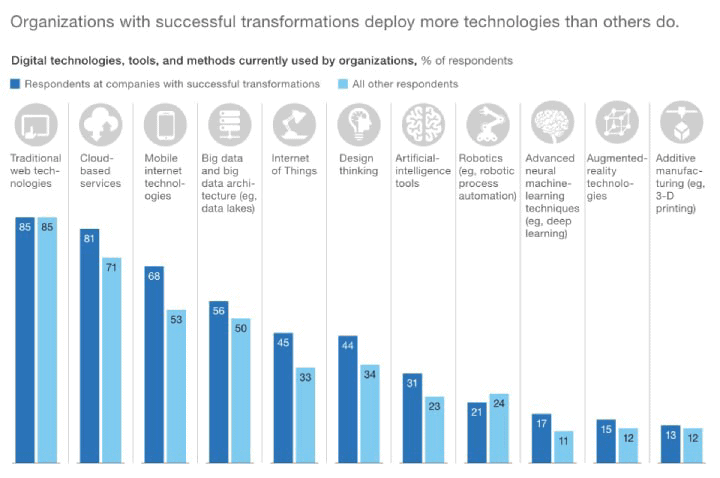
Digital Transformation Strategy
Digital technologies have the power to reshape industries across varied sectors. Over recent years, more and more companies have been adopting digital technologies on a large scale to keep pace with the trends as well as their competition. Yet, a 2015 study by McKinsey indicated that less than one-third of organizational transformations were successful.
A more recent survey in 2018 suggested that the success rate might be even lower than previous estimates with only 16% of the survey respondents saying that digital transformation has helped their organizations improve performance and equip them with sustainable gains in the long term.
A point to note in this regard is that most digital transformations that fail do so not due to the technology but because of organizational and cultural challenges. The level of maturity of the organization affects the success rate to a large extent. In general, as organizations reach a higher level of maturity, they develop all the four types of digital technologies – mobile, social, analytics, and cloud – in equal measure.
Moreover, they are more likely to use more sophisticated technologies such as the IoT application development , Machine Learning and Artificial Intelligence app development. However, the success of digital transformation depends less on the type of technology used than on strategy.
Image Source: McKinsey
Digital Transformation: Developing the right strategy
The following points serve as a guide when developing digital transformation strategies:
1) Begin with defining the business objectives
Often, the reason that digital transformation fails is that organizations focus on the technologies to be employed instead of evaluating how technology can help in achieving specific business objectives. The first step should be to determine the business outcome that the organization hopes to achieve. Based on this, the right technology can be chosen. For instance, if the business objective is to serve customers better through faster response time, then by working backward, the organization can select a technology that offers speedy responses and flexibility to achieve the goal.
2) Involve insiders to understand what works
There isn’t a one size fits all solution when it comes to implementing digital transformation strategies in an organization. While best practices may serve as a guide to the various areas where technologies can be used, it’s best to rely on the expertise of insiders who have in-depth knowledge and experience about what works and what doesn’t. One of the reasons why digital transformation fails in organizations is because the views of the staff who are involved in the daily operations are not sought. Therefore, it is essential to research the workflow processes and gather insights from insiders before any technology is implemented.
3) Start with automating the most tedious tasks
Resistance to technological change in the organization is inevitable as employees fear that technology will replace them. As a result, they are slow to adopt it, which often has a negative impact on performance. A common mistake many organizations make is focusing on using technology to lower costs by replacing humans. However, such an approach reduces employee morale and causes a decrease in overall effectiveness.
A better approach would be to use technology to enhance the efficiency of employees. The best solution for encouraging employees to adopt the new technology is by automating the most tedious tasks first as they will experience the benefits of having more time to focus on important tasks while the robots or machines take care of the low-level tasks.
4) Adopt an outside-in approach to customer experience
If the primary goal of digital transformation is to improve customer experience, then it is essential to gather inputs from customers to understand their expectations. Rather than formulating strategies based on the company’s internal goals, it makes sense to follow an outside-in approach and get inputs from customers, agents and other stakeholders who regularly interact with the customers.
Sometimes, instead of implementing a single tool to improve customer satisfaction, making smaller changes by adopting a varied set of tools at different points of the service cycle can be more productive.
5) Allow technology to transform the way employees work
Every few years, as newer technologies come into play, they completely alter perceptions on the way things work. For instance, compared to a couple of decades ago, the workplace thrives on a more collaborative approach, where employees depend less on their cognitive skills and more on social skills. With the implementation of technology, this trend will only gain momentum as employees will have more time to collaborate and design work that the machines can do.
Since digital transformation requires experimentation with making changes provisionally and then adjusting to rectify aspects that don’t work, organizations need to be more agile in decision making. Given this requirement, it’s wise to have a flat structure that facilitates quick decisions.
Also Read:
Digital Transformation: A blueprint to the digital future
Why technology shouldn’t be the only focus
While technology is an essential component of digital transformation, it is successful only when the various digital technologies – mobile, social, analytics and cloud – integrate to produce the best results. The McKinsey study shows that digital leaders stand apart from the rest due to a robust digital strategy that accounts for the organization’s culture and leadership.
Often, the reason for digital transformation failure is that companies implement technology without making the necessary changes in culture, mindsets, and processes, all of which are crucial for allowing the technology to demonstrate its potential.
Conclusion
Digital transformation is still relatively new, and therefore, it’s too early to define the factors that ensure the successful implementation of digital technologies. At best, the experiences of digitally mature Digital transformation company can be referred to compile best practices.
Besides the need to have the right strategies in place to alter culture, processes, and mindsets that foster successful transformation, companies should focus on letting their future goals determine the most suitable technology, instead of the other way around.




